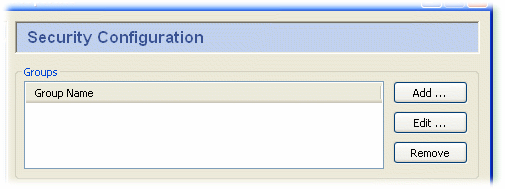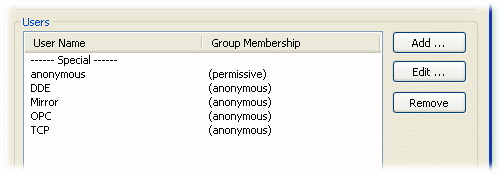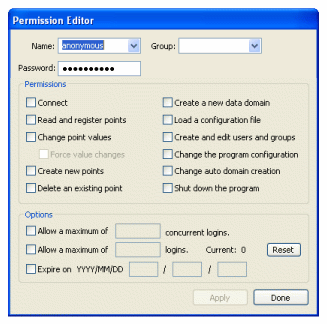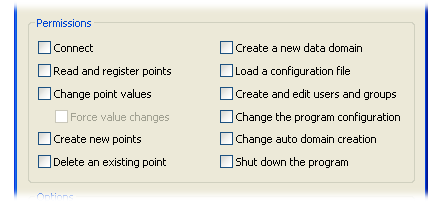| OPC DataHub™ : Version 6.4 | ||
|---|---|---|
 | Chapter 19. Properties Window |  |
 | This option in the Properties Window sets up security for the OPC DataHub. For more information on DataHub security, please refer to Chapter 16, Security. |
Groups provide a common security configuration for any number of users. To add or edit a group, press the or and enter the necessary information in the Permission Editor.

There are two kinds of users--normal and special. Normal users correspond to individuals with a name and a password. Special users provide a way to offer different security models for different protocols. For more information on types of users, please refer to Section 16.2, “User Authentication”.
To add or edit a user, press the or button and enter the necessary information in the Permission Editor.

The Permission Editor allows you to change the permissions for any user or group.

Check or uncheck the boxes to assign permissions.

This user is allowed to maintain a connection to the OPC DataHub. When a connection is made, the client has a 5-second grace period in which to authenticate before the client is disconnected. If the client does not have permissions after the grace period expires, it will be disconnected.
This user is allowed to read point values and subscribe to point value changes.
This user is allowed to write a new point value to the OPC DataHub.
This user is allowed to create new points in existing data domains in the OPC DataHub.
This user is allowed to delete a point from the OPC DataHub.
![[Important]](images/important.gif) | Normally, no client should be allowed to delete points from the OPC DataHub. Deleting points can be very disruptive for existing clients. Use this permission with caution. |
This user is allowed to create new data domains. Normally you should also set permission when you set this permission for a user.
This user is allowed to tell the OPC DataHub to load a specific configuration file.
This user is allowed to create and edit users and groups non-interactively.
This user is allowed to transmit commands to the OPC DataHub to alter the DataHub's configuration. This normally includes actions like enabling and disabling particular interfaces and functions within the dho.
This user may change the flag indicating whether the OPC DataHub should automatically create a data domain when a user requests a point in a non-existent data domain.
This user may transmit an exit command to the OPC DataHub, causing it to shut down.
Here you can specify maximum numbers for logins, and login expiry dates.

If this option is selected the user will be limited to N concurrent connections, regardless of the connection type. For example, if N is 2, the user would be allowed to make 2 TCP connections, or one TCP and one DDE connection. This option also applies to anonymous users.
This user is allowed to connect to the OPC DataHub at most N times, ever. Once the user has connected to the DataHub this many times, future attempts to log in will be refused. The DataHub remembers the login count for each user even after it has been restarted.
If this option is selected, the user will be allowed to log in to the OPC DataHub up to, but not including, the date selected.
Copyright © 1995-2010 by Cogent Real-Time Systems, Inc. All rights reserved.